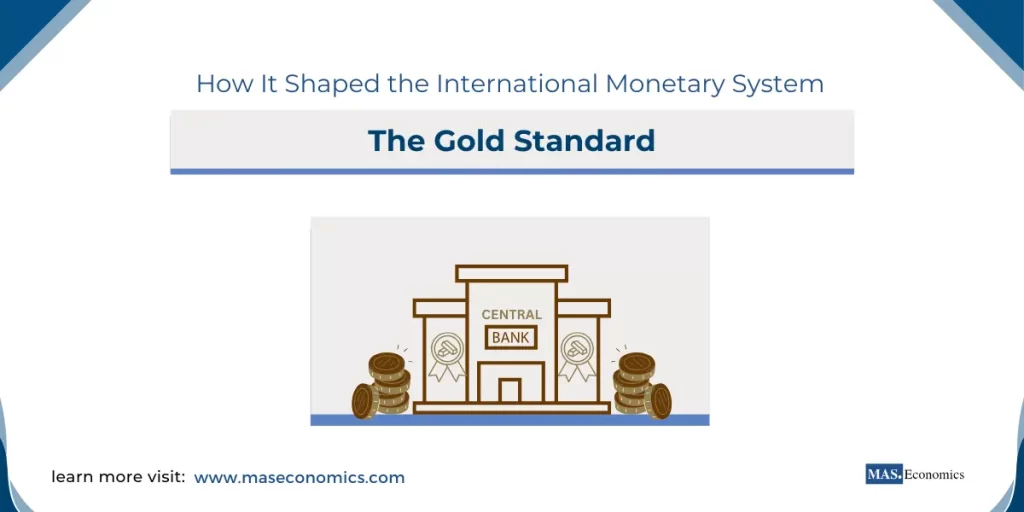The gold standard was once the foundation of international finance, linking economies and shaping central banking. But what exactly was the gold standard, and how did it influence the modern financial system? This exploration covers its history, impact on central banking, and international trade, and its lasting effects on monetary stability
What Was the Gold Standard?
The gold standard was an international monetary system in which the value of a country’s currency was directly linked to a specific amount of gold. In other words, under this system, governments guaranteed that their currency could be exchanged for a fixed quantity of gold. The gold standard established a framework for stable exchange rates and fostered trust in international trade.
The classical gold standard emerged prominently in the late 19th century, largely influenced by the economic and financial power of Great Britain. By tying their currencies to gold, countries created a system of fixed exchange rates, which facilitated stable international trade relationships and capital flows.
The Emergence of the Gold Standard
The Historical Context
The emergence of the gold standard wasn’t planned—it was more of an “accident of history.” Historically, the gold standard evolved from earlier monetary systems that used various metals such as gold, silver, and copper. The process began when Britain adopted a de facto gold standard in the early 18th century, largely due to an unintended shift from silver to gold in currency circulation.
The adoption of the gold standard spread throughout Europe in the 19th century, driven by Britain’s economic dominance during the Industrial Revolution. Other nations, seeking to simplify trade and secure favorable borrowing conditions, saw value in following Britain’s lead. This period of monetary evolution eventually led to a system where most major economies had tied their currencies to a fixed amount of gold by the late 1800s.
Key Principles of the Gold Standard
- Fixed Exchange Rates: Under the gold standard, currencies were valued in terms of gold, establishing a stable system of exchange rates. This made international trade more predictable and reduced exchange rate risk.
- Gold as a Medium of Settlement: International payments between countries were often settled in gold, and gold was used to balance deficits or surpluses in the balance of payments.
- Lender of Last Resort: The advent of fractional reserve banking presented new risks, such as bank runs, which created a role for central banks as lenders of last resort to stabilize the financial system without necessarily breaching gold standard constraints.
How the Gold Standard Influenced Central Banking
The Role of Central Banks
The gold standard fundamentally influenced the role of central banks. Central banks were responsible for maintaining the gold standard’s stability, which often meant defending the fixed exchange rate at all costs. This required strict control over the money supply and interest rates. For example, during periods of economic crisis or trade deficits, a central bank might raise interest rates to prevent gold outflows, which could stabilize the currency but at the cost of reducing domestic investment and increasing unemployment.
The gold standard also required central banks to hold substantial reserves of gold. These reserves were crucial for maintaining confidence in the currency’s stability and for settling international accounts. This reserve requirement meant that the central bank’s ability to provide liquidity during crises was directly limited by the availability of gold.
Balancing Gold Reserves and Economic Stability
A central dilemma during the gold standard era was balancing the need for adequate gold reserves with economic stability. If a country experienced a deficit in its balance of payments, it would see a gold outflow to creditor nations. This gold loss reduced the country’s money supply, leading to deflation and a slowdown in economic activity.
The gold standard’s requirement to back currency with gold often forced central banks into pro-cyclical monetary policies—tightening credit when gold reserves were low, even if the economy was already struggling. This rigidity sometimes worsened economic downturns, as seen in the economic crises that occurred during the 19th and early 20th centuries.
The Gold Standard and International Trade
Fixed Exchange Rates and Trade Predictability
One of the significant advantages of the gold standard was the stability it provided to international trade. With fixed exchange rates, traders and investors could enter long-term contracts without the fear of adverse currency movements, which reduced transaction costs and uncertainties. For countries such as Great Britain, this system fostered an international environment in which trade could flourish, promoting global economic integration.
However, this predictability came at a cost. When countries experienced imbalances in trade, they couldn’t simply devalue their currency to make their exports cheaper. Instead, they needed to allow deflation to lower domestic prices and restore competitiveness—a painful process that often led to economic hardship, especially for countries with high public debt or structural trade deficits.
The Impact on Developing Nations
The adoption of the gold standard by developing nations was often a double-edged sword. On one hand, aligning with the gold-backed system boosted investor confidence and helped these nations borrow money more easily. On the other hand, the rigidity of the gold standard could be punishing during economic downturns. Developing countries lacked the flexibility to print money in response to domestic needs, leading to periods of intense deflation and economic stagnation.
Countries like Argentina faced significant challenges under the gold standard. With limited economic diversification and heavy reliance on commodity exports, Argentina’s adherence to the gold standard often meant that global commodity price swings directly affected its economic stability, leading to financial instability during downturns.
Challenges and Demise of the Gold Standard
Vulnerabilities of the Gold Standard
Despite its appeal, the gold standard had notable vulnerabilities. One such weakness was its reliance on the availability of gold, which inherently limited monetary expansion. The rise of fractional reserve banking further complicated things, as it introduced financial vulnerabilities that could trigger bank runs and systemic crises.
The gold standard also imposed a deflationary bias. If a country loses gold due to trade deficits, the money supply contracts, leading to deflation. This deflation made it difficult for businesses to borrow and invest and often led to higher unemployment. The effects were most pronounced during the Great Depression of the 1930s when countries adhering to the gold standard were forced into deep deflationary spirals as they struggled to maintain their gold reserves.
The Interwar Period and the End of the Gold Standard
The interwar period highlighted many of the gold standard’s flaws. As countries sought to recover from the economic devastation of World War I, the rigidities of the gold standard made coordinated recovery challenging. Countries that clung to the gold standard experienced deeper recessions, while those that abandoned it were able to recover more quickly by devaluing their currencies and adopting expansionary monetary policies.
The final blow to the classical gold standard came during the Great Depression when the pressure to maintain gold convertibility proved unsustainable for many economies. The massive economic contractions and high unemployment rates forced governments to prioritize domestic economic recovery over international monetary commitments, leading most nations to abandon the gold standard entirely by the mid-1930s.
The Legacy of the Gold Standard in Modern Central Banking
Lessons Learned for Modern Monetary Policy
The gold standard left a lasting impact on modern central banking and monetary policy. The system demonstrated both the strengths and limitations of having a currency directly tied to a tangible asset. The need for international monetary cooperation during gold-standard crises laid the foundation for later institutions like the International Monetary Fund (IMF), which aimed to promote global monetary stability without the constraints of a rigid gold link.
The gold standard also highlighted the dangers of deflationary pressures and the need for flexibility in monetary policy. Modern central banks, such as the Federal Reserve and the European Central Bank, have learned to manage inflation and provide liquidity in times of crisis, adopting policies that balance price stability with economic growth objectives—something that was difficult to achieve under the gold standard.
A Return to the Gold Standard? Modern Perspectives
There have been occasional calls for a return to the gold standard, particularly during periods of high inflation or financial instability. Proponents argue that a return to gold would prevent governments from printing excessive amounts of money and devaluing their currencies. However, most economists argue against this idea, pointing to the lack of flexibility and the potential for severe economic downturns similar to those experienced in the 19th and early 20th centuries.
Modern monetary systems, while not without faults, offer central banks the flexibility needed to respond to economic challenges—a flexibility that was fundamentally restricted under the gold standard.
Conclusion
The gold standard was a critical stage in the evolution of the international monetary system, profoundly shaping the way central banks operate and influencing the structure of international trade and finance. While it provided stability and predictability in exchange rates, its rigidity often led to significant economic hardships, especially during periods of global economic stress.
The history of the gold standard highlights the complexities of modern central banking and underscores the need for flexible monetary policy. Though unlikely to return, the lessons from its successes and failures still guide the strategies of today’s central banks.
FAQs:
What was the gold standard?
The gold standard was a monetary system in which a country’s currency was directly linked to a fixed amount of gold. Under this system, governments guaranteed that their currency could be exchanged for a specific quantity of gold, establishing a stable exchange rate framework for international trade.
How did the gold standard influence international trade?
The gold standard provided stable exchange rates, reducing currency risk in international trade. This stability allowed countries to engage in trade and investment more confidently, as they could predict exchange rates. However, it limited countries’ ability to adjust currency values to manage trade imbalances.
Why did central banks play a crucial role under the gold standard?
Central banks were essential for maintaining the gold standard’s stability. They regulated money supply and interest rates to defend fixed exchange rates, often raising interest rates during economic crises to prevent gold outflows. This created a balance between currency stability and domestic economic needs, though it sometimes led to economic challenges.
What were the main challenges of the gold standard?
The gold standard’s fixed nature often led to economic hardship during downturns. Countries couldn’t devalue their currency to manage trade deficits, forcing deflation and reduced economic activity. The reliance on gold reserves also restricted monetary expansion, limiting central banks’ flexibility during financial crises.
How did the gold standard contribute to the Great Depression?
The gold standard’s rigid framework worsened the Great Depression by forcing deflationary policies to maintain gold convertibility. Countries adhering to the gold standard experienced prolonged economic contraction, while those that abandoned it recovered more quickly by devaluing their currency and adopting flexible monetary policies.
What is the legacy of the gold standard in modern central banking?
The gold standard demonstrated the need for monetary flexibility and international cooperation, influencing the design of modern central banks and institutions like the IMF. Modern central banks balance inflation control with economic growth objectives, flexibility the gold standard’s rigidity made difficult.
Are there any calls to return to the gold standard?
Some advocates suggest returning to the gold standard to control inflation and limit government spending, arguing it would prevent excessive money printing. However, most economists oppose this idea, citing the lack of flexibility and potential for economic hardship similar to past experiences under the gold standard.
Thanks for reading! Share this with friends and spread the knowledge if you found it helpful.
Happy learning with MASEconomics




